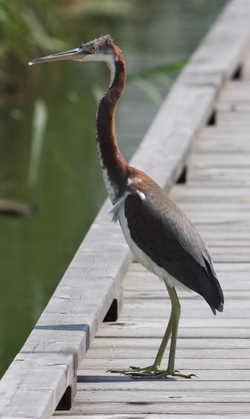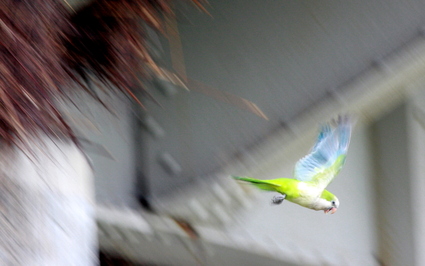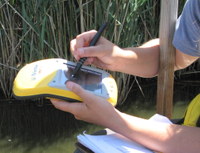We shot this heron video Friday and edited over the weekend. The video should be played with the volume on.
We did not see the tricolored heron on Monday morning.
Photo below was taken by James Kuehlke on Friday.

Update: Heron was still here toward the beginning of the Marsh Discovery Trail as of 4 p.m. Friday. He was near the second structure on the right as you walk in. Fabulous looks at the bird.
The tide gate is opening at the impoundment soon, and the water level will drop — no guarantee the tricolored will stay much longer.
We are told the bird was first seen at DeKorte on Tuesday. If you have a significant sighting in the Meadowlands, please e-mail Jim Wright.
I hope to post a video on Monday.
We were walking along the Marsh Discovery Trail around 3:30 p.m. Thursday when we saw this amazing (and very small) heron walking in front of us.
The juvenile tricolored was not skittish at all, and as a family neared him as they walked along the boardwalk, he hoped in the water by the boardwalk, then perched on a handrail (above), then flew.
Click "Continue reading" to see more shots.
 We saw this immature tricolored heron walking down the boardwalk at DeKorte Park in Lyndhurst.
We saw this immature tricolored heron walking down the boardwalk at DeKorte Park in Lyndhurst.
More on tricolored herons here.
Will post more pix of this cute little guy on Friday.
It’s not too early to mark your calendar for the 5th annual Meadowlands Festival of Birding, sponsored by the Meadowlands Commission.
The event is set for Saturday Sept. 13 and Sunday Sept. 14. (Above photo was taken at the Kearny Marsh.)
Click here for more information.
A lot of people have heard of the monk parakeets of Edgewater or Fort Lee, but far fewer are aware of a colony in the Meadowlands, above the railroad tracks on a bridge along Railroad Avenue.
You'll hear their racket before you see them. They have been in Ridgefield for a several years, and are likely descendants of escaped birds. They're also called quaker parrots.
Read more about monk parakeets here.
Tree swallows are thriving in the Meadowlands once again, thanks to an innovative nesting box program.
And the New Jersey Meadowlands Commission now has the data to prove it.
With a huge boost from local scout troops, families and other groups, the Meadowlands Commission has erected some 250 nesting boxes in marshes throughout the 30.4-square-mile district.
This year, with the help of  GPS devices, the Meadowlands Commission naturalists Mike Newhouse and Gabrielle Bennett-Meany are keeping track of tree-swallow activity in all of the nesting boxes.
GPS devices, the Meadowlands Commission naturalists Mike Newhouse and Gabrielle Bennett-Meany are keeping track of tree-swallow activity in all of the nesting boxes.
They found that more than 60 percent were occupied by nesting pairs, with 610 eggs laid and more than 480 nestlings successfully fledged as of July 15.
Click "Continue reading…" for more images and information.